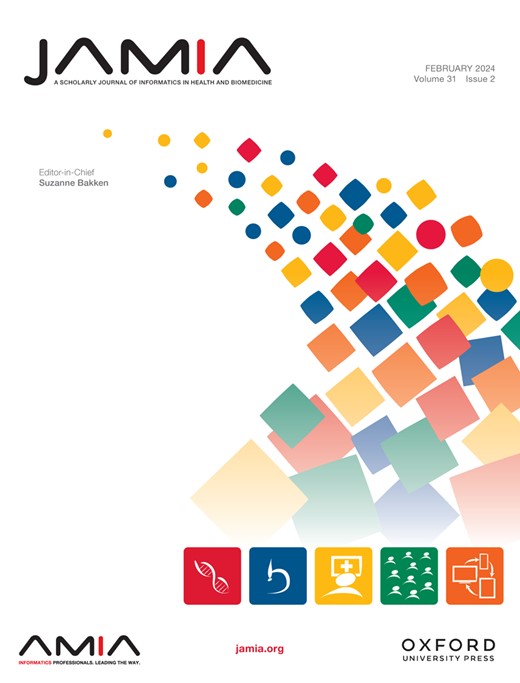"Goldmine" or "big mess"? An interview study on the challenges of designing, operating, and ensuring the durability of Clinical Data Warehouses in France and Belgium.
IF 4.7
2区 医学
Q1 COMPUTER SCIENCE, INFORMATION SYSTEMS
Journal of the American Medical Informatics Association
Pub Date : 2024-09-12
DOI:10.1093/jamia/ocae244
引用次数: 0
Abstract
OBJECTIVES Clinical Data Warehouses (CDW) are the designated infrastructures to enable access and analysis of large quantities of electronic health record data. Building and managing such systems implies extensive "data work" and coordination between multiple stakeholders. Our study focuses on the challenges these stakeholders face when designing, operating, and ensuring the durability of CDWs for research. MATERIALS AND METHODS We conducted semistructured interviews with 21 professionals working with CDWs from France and Belgium. All interviews were recorded, transcribed verbatim, and coded inductively. RESULTS Prompted by the AI boom, healthcare institutions launched initiatives to repurpose data they were generating for care without a clear vision of how to generate value. Difficulties in operating CDWs arose quickly, strengthened by the multiplicity and diversity of stakeholders involved and grand discourses on the possibilities of CDWs, disjointed from their actual capabilities. Without proper management of the information flows, stakeholders struggled to build a shared vision. This was evident in our interviewees' contrasting appreciations of what mattered most to ensure data quality. Participants explained they struggled to manage knowledge inside and across institutions, generating knowledge loss, repeated mistakes, and impeding progress locally and nationally. DISCUSSION AND CONCLUSION Management issues strongly affect the deployment and operation of CDWs. This may stem from a simplistic linear vision of how this type of infrastructure operates. CDWs remain promising for research, and their design, implementation, and operation require careful management if they are to be successful. Building on innovation management, complex systems, and organizational learning knowledge will help."金矿 "还是 "烂摊子"?关于法国和比利时临床数据仓库的设计、运行和耐用性挑战的访谈研究。
目的 临床数据仓库(CDW)是访问和分析大量电子健康记录数据的指定基础设施。建立和管理此类系统需要大量的 "数据工作 "以及多个利益相关者之间的协调。我们的研究重点是这些利益相关者在设计、运行和确保用于研究的 CDW 持久性时所面临的挑战。材料与方法 我们对来自法国和比利时的 21 位从事 CDW 工作的专业人士进行了半结构化访谈。结果在人工智能热潮的推动下,医疗保健机构在没有明确如何产生价值的情况下,开始着手重新利用他们为医疗保健产生的数据。由于参与其中的利益相关者多种多样,加上关于社区数据中心可能性的宏大论述与实际能力脱节,社区数据中心的运营很快出现了困难。由于没有对信息流进行适当管理,利益相关方难以形成共同愿景。这一点在受访者对确保数据质量的最重要因素的不同理解中显而易见。受访者解释说,他们在管理机构内部和机构之间的知识方面举步维艰,导致知识流失、错误不断,阻碍了地方和国家的进步。这可能源于对这类基础设施如何运行的简单线性看法。煤层气数据中心在研究方面仍然大有可为,要想取得成功,其设计、实施和运行都需要精心管理。以创新管理、复杂系统和组织学习知识为基础将有所帮助。
本文章由计算机程序翻译,如有差异,请以英文原文为准。
求助全文
约1分钟内获得全文
求助全文
来源期刊
CiteScore
14.50
自引率
7.80%
发文量
230
审稿时长
3-8 weeks
期刊介绍:
JAMIA is AMIA''s premier peer-reviewed journal for biomedical and health informatics. Covering the full spectrum of activities in the field, JAMIA includes informatics articles in the areas of clinical care, clinical research, translational science, implementation science, imaging, education, consumer health, public health, and policy. JAMIA''s articles describe innovative informatics research and systems that help to advance biomedical science and to promote health. Case reports, perspectives and reviews also help readers stay connected with the most important informatics developments in implementation, policy and education.

 求助内容:
求助内容: 应助结果提醒方式:
应助结果提醒方式:


